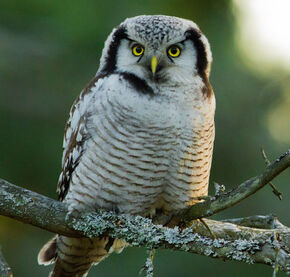The Northern Hawk-Owl (Surnia ulula), or Northern Hawk Owl in North America, is a non-migratory owl that usually stays within its breeding range, though it sometimes irrupts southward. It is one of the few owl species that are not nocturnal or crepuscular. This is the only living species in the genus Surnia of the family Strigidae, the "typical" owls (as opposed to barn owls, Tytonidae). The species is sometimes called simply the Hawk Owl; however, many species of owls in the Ninox genus are also called "hawk owls".
Description[]
Male Northern Hawk-Owls are generally 36.0–42.5 cm long and weigh 300 g. Females are slightly bigger with a length of 37.2–44.7 cm and a mass of about 340g. Both males and females have similar wingspans of about 45 cm. The Northern Hawk-Owl plumage is relatively dark brown with an off-white spotting pattern on all dorsal parts of the body, except for the back of the neck, which boasts a black v-shaped pattern. The underbelly is generally white or off-white which continues to the toes with brown bands on the breast and stomach. It also boasts a long tail with brown banding. The Northern Hawk-Owl has a smokey white face with a black border, a flat head, yellow eyes, and a yellow curved beak.
The Northern Hawk-Owl has been said to resemble a hawk in appearance and behavior. In North America, its appearance in flight is often considered similar to a Cooper's Hawk (Accipiter cooperii). It has been suggested that this may be because the Hawk-Owl may partially fill an important diurnal niche similar to that of day hunters such as hawks.
Vocalization[]
S. ulula has a variety of calls used by the different sexes in different situations. When attracting a mate the male usually lets out a rolled whistle of ulululululululul and a sound similar to tu-wita-wit, tiwita-tu-wita, wita, when perching at a potential nest site. The female’s call is usually less constant and more shrill.
When alerting to danger, the Northern Hawk-Owl lets out a sound similar to rike, rike, rike, rike. It also releases a high-pitched scream followed by a yip when an intruder is near to the nest. To warn of impending dangers to a fledgling, the Hawk-Owl will let out a noise similar to ki ki kikikikiki. Calls can vary in length from 15 s to 2 min.
Distribution[]
Three subspecies exist across the northern holarctic. The North American subspecies S.u.caparoch spans from eastern Alaska through to Newfoundland and in some areas extends south into the northern United States. The other two subspecies are found in Eurasia: S. u. tianschanica breeds in central Asia reaching Xinjiang (China) and S. u. ulula resides across Eurasia reaching Siberia at its most eastern range.
Occasionally, S.u.caparoch can extend its territory as far south as northern Minnesota and many other states in the northern United States including more central states such as West Virginia, New York, and South Dakota. These southern forays into the northern United States are rare and generally occur during winter, or following an explosion in a population of prey.S. u. caparoch has been known to reach Great Britain. As in North America, the Eurasian subspecies can occasionally be found in more southern areas such as the following: Great Britain; and southern Russia.
Habitat[]
Northern Hawk Owls are unevenly distributed and highly variable throughout the boreal forest. They live in open coniferous forests or coniferous forests with deciduous species such as larch, birch, poplar, and willow. They are found in muskegs, clearings, swamp valleys, meadows, or recently burnt areas, and generally avoid dense spruce-fir forests. Winter habitat is usually the same as breeding habitat.
Breeding[]
The Northern Hawk-Owl generally starts its mating rituals at the beginning of March. After calling and pairing is complete the Northern Hawk-Owl will build a nest and start to lay eggs. On average the Northern Hawk-Owl will lay 3–11 eggs per brood. The nest sites are usually the tops of hollow stumps of old dead spruce trees. These nesting sites are usually 2-10m above ground for the North American S. u. caparoch and approximately 4-5m above ground for the Eurasian S. u. ulala. The specific dates of egg appearance can be quite variable depending on locality. In central Canada eggs are usually laid from March 30 to the 5th of June. In Newfoundland the appearance of eggs occurs later, between May 9 and June 11. In Finland however, eggs can be found anywhere between the 30th of March to the 23rd of June.
For the most part, the female Northern Hawk-Owl does the incubating of the eggs whilst the male forages for food. Once the chicks have hatched their roles shift drastically. At about two weeks into the chicks' lives, the female starts to leave the nest for long periods of time (5 hours or more). This span of time is presumably when the female hunts. The male however, will guard the nest diligently until the chicks leave. When predators (usually other raptors) fly nearby, the male will sometimes chase them away from the nest if they feel it is necessary. Once the owlets have grown to a size which allows less parental supervision, they will leave the nest. This occurs on average after their 21st day, and can begin as early as mid-June. After this the female will provide most of the care. However, the male will remain close and will still feed his young on occasion. The Northern Hawk-Owl has also been known to nest on cliffsides. It has little fear of humans and will attack if the young are approached too closely.
Feeding[]
The Northern Hawk-Owl feeds on a variety of prey, which can include small rodents to mammals more robust in size, and a variety of birds, a typical diet for many boreal owls. In Eurasia, the Northern Hawk-Owl is known to feed primarily on voles from the Microtus family. These voles usually follow a 3–4 year cycle of abundance. Therefore, S. u. ulula numbers are affected negatively when the numbers of voles are lowest. In North America, the subspecies S. u. caparoch also feeds upon microtine voles, but its population is primarily based on the ten-year cycling of the Snowshoe Hare (Lepus americanus). In Eurasia, the Northern Hawk-Owl’s biomass consists of about 94% microtine voles, whereas in North America the percentage of biomass contributed by voles can be as low as 20%. Juvenile hares are considerably more important at 40–50%.
Other animals that are important prey items for the Northern Hawk-Owl include the red squirrel (Sciurus vulgaris) which has been documented to contribute as much as 20% to the Hawk-Owl’s biomass. A long list of others include mice, rats, voles, lemmings, the short-tail weasel (Mustela erminea), partridge, Spruce Grouse (Falcipennis canadensis), doves, Pileated Woodpeckers (Dryocopus pileatus), sparrows, jays, robins, starlings, buntings, grackles, and finches. In the winter, feeding strategies change; where in summer the main source of food is mammals, in the winter a bigger portion of the Hawk-Owl’s biomass consists of ground-dwelling birds, such as the ptarmigan and the grouse.
The Northern Hawk-Owl is a partially diurnal hunter, although it has been recorded hunting at varying times and does not appear to have a preferred hunting time. Whether the bird resides in Eurasia or North America, the strategy is usually similar. The Northern Hawk-Owl will perch and scour the immediate area for prey. As these owls are considered a search-oriented species they likely do not stay put for long if the site is not producing prey. The Hawk-Owl prefers open, forest-type environments when perching. These environments include sphagnum bogs and partially deforested areas. The preferred perching tree of the Northern Hawk-Owl is the spruce tree. When the Hawk-Owl attacks, it goes from a horizontal posture into a gliding dive. If the prey is further away, the bird will flap its wings a few times during the dive to increase distance. The Hawk Owl has exceptional hearing and can plunge into snow to capture rodents below the surface.
The type of prey the Hawk-Owl catches will determine its' eating strategy. For mammalian prey the ritual is generally the same: the Northern Hawk-Owl will eviscerate its' prey, eats the head first (especially for prey like the red squirrel, whose head is fairly large), and then—when tackling larger prey—it will eat the organs and cache the remains; with smaller prey, the owl will simply swallow the body whole.
History[]
To Be a King[]
A Northern Hawk Owl named Sir Tobyfyor (Toby for short) was a member of Hoole's parliament.
The Rise of a Legend[]
A Great Horned Owl slipgizzle leads an attack on the secret training ground, and among his small gang are Hawk Owls. One Hawk owl tries to attack Blix, but misses and goes kerplonken upon seeing a snow leopard leaping at them, crashing to the ground and breaking its neck. Another Hawk Owl is brought down by one of the Great Gray Kielian League recruits.
Trivia[]
- The genus name Surnia is a word made up by French zoologist André Duméril.
- The species name ulula is Latin for "screech owl".



